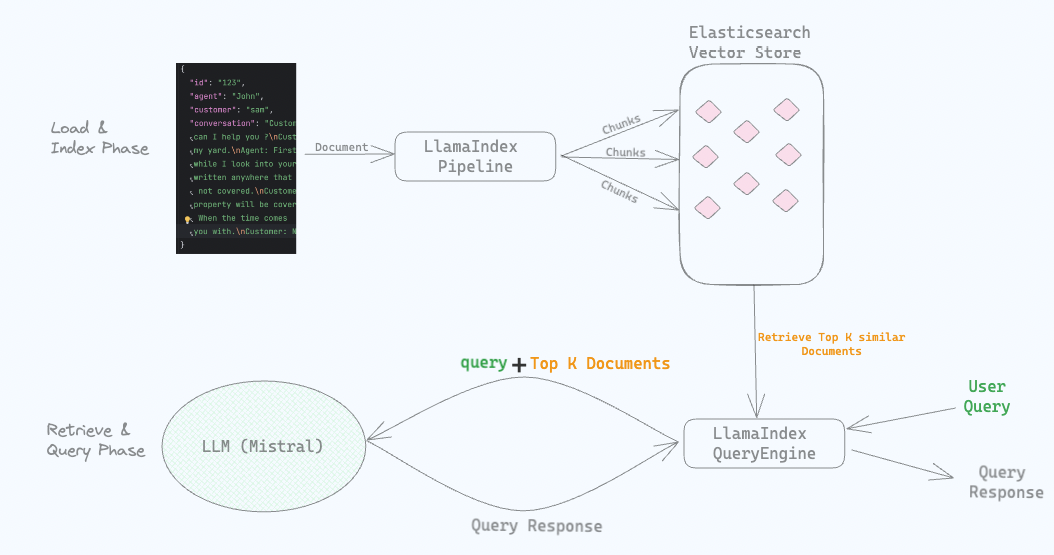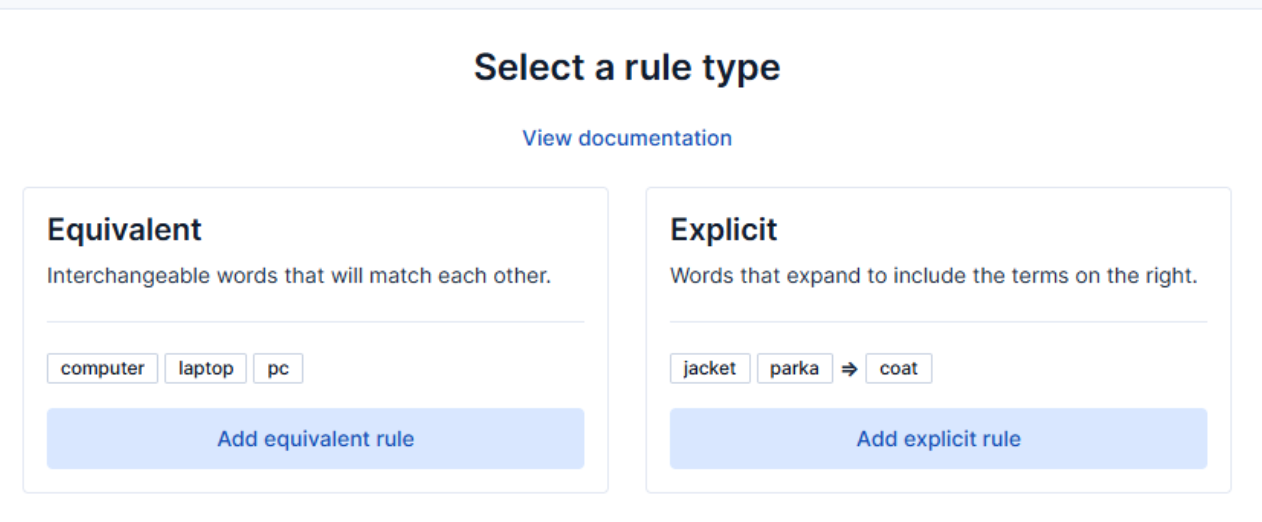In this post we will look at ways to protect Personal Identifiable Information (PII) and sensitive data when using public LLMs in a RAG (Retrieval Augmented Generation) flow. We will explore masking PII and sensitive data using open source libraries and regular expressions as well as using local LLMs to mask data before invoking a public LLM.
Before we begin, let us review some terminology we use in this post.
Terminology
LlamaIndex is a leading data framework for building LLM (Large Language Model) applications. LlamaIndex provides abstractions for various stages of building a RAG (Retrieval Augmented Generation) application. Frameworks like LlamaIndex and LangChain provide abstractions so that applications don’t get tightly coupled to the APIs of any specific LLM.
Elasticsearch is offered by Elastic. Elastic is an industry leader behind Elasticsearch, a scalable data store and vector database that supports full text search for precision, vector search for semantic understanding, and hybrid search for the best of both worlds. Elasticsearch is a distributed, RESTful search and analytics engine, scalable data store, and vector database. The Elasticsearch capabilities we use in this blog are available in the Free and Open version of Elasticsearch.
Retrieval-Augmented Generation (RAG) is an AI technique/pattern where LLMs are provided with external knowledge to generate responses to user queries. This allows LLM responses to be tailored to a specific context and less generic.
Embeddings are numerical representations of the meaning of text/media. They are lower-dimensional representations of high-dimensional information.
RAG and Data Protection
Generally, Large Language Models (LLMs) are good at generating responses based on information available in the model which may be trained on internet data. However, for those queries where information is not available in the model LLMs need to be supplied with external knowledge or specific details not contained within the model. Such information might be in your database or internal knowledge system. Retrieval-Augmented Generation (RAG) is a technique where, for a given user query, you first retrieve relevant context/information from external (to the LLMs) systems (e.g your database) and send that context along with the userquery to LLM to generate a more specific and relevant response.
This makes RAG technique highly effective for applications in question answering, content creation, and anywhere a deep understanding of context and detail is beneficial.
As a result, in a RAG pipeline you run the risk of exposing internal information like PII (Personal Identifiable Information) and sensitive information (e.g names, date of births, account numbers etc ) to public LLMs.
Although your data is secure when using a vector database like Elasticsearch (through various levers like Role based Access Control, Document Level Security etc), care must be taken when you send data outside to a public LLM.
Protecting Personally Identifiable Information (PII) and sensitive data is crucial when using large language models (LLMs) for several reasons:
- Privacy Compliance: Many regions have strict regulations, such as the General Data Protection Regulation (GDPR) in Europe or the California Consumer Privacy Act (CCPA) in the United States, which mandate the protection of personal data. Compliance with these laws is necessary to avoid legal consequences and fines.
- User Trust: Ensuring the confidentiality and integrity of sensitive information builds user trust. Users are more likely to use and interact with systems that they believe will safeguard their privacy.
- Data Security: Protection against data breaches is essential. Sensitive data exposed to LLMs without adequate safeguards can be susceptible to theft or misuse, leading to potential harm such as identity theft or financial fraud.
- Ethical Considerations: Ethically, it's important to respect users' privacy and handle their data responsibly. Mishandling PII can lead to discrimination, stigmatization, or other negative societal impacts.
- Business Reputation: Companies that fail to protect sensitive data may suffer damage to their reputation, which can have long-term negative effects on their business, including loss of customers and revenue.
- Reduction of Abuse Risks: Secure handling of sensitive data helps in preventing malicious use of the data or the model, such as training the models on biased data or using the data to manipulate or harm individuals.
Overall, robust protection of PII and sensitive data is necessary to ensure legal compliance, maintain user trust, ensure data security, uphold ethical standards, protect business reputation, and reduce the risk of abuse.
Quick recap
In the previous post we discussed how to implement Q&A experience using a RAG technique with Elasticsearch as a vector database while using LlamaIndex and a locally running Mistral LLM. Here we build upon that.
Reading the previous post is optional as we will now quickly discuss/recap what we did in the previous post.
We had a sample dataset of call center conversations between agents and customers of a fictional Home insurance company. We built a simple RAG application which answered questions like “What kind of water related issues are customers filing claims for ?”.
At a high level this is how the flow looked.

During the Indexing phase, we loaded and Indexed Documents using the LlamaIndex pipeline. The documents were chunked and stored in the Elasticsearch vector database along with their embeddings.
During the query phase when the user asked a question, LlamaIndex retrieved top-K similar documents that were relevant to the query. These top-K relevant documents along with the query were sent to the locally running Mistral LLM which then generated the response to be sent back to the user. Feel free to go through the previous post or explore the code.
In the previous post we had the LLM running locally. However, in production you may want to use an external LLM provided by various companies like OpenAI, Mistral, Anthropic etc. It could be because your use case needs a larger foundational model or running locally is not an option due to enterprise production needs like scalability, availability, performance etc.
Introducing an external LLM in your RAG pipeline exposes you to a risk of inadvertently leaking sensitive and PII to the LLMs. In this post we will explore options on how to Mask PII information as part of your RAG pipeline before sending documents to an external LLM.
RAG with a public LLM
Before discussing how to protect your PII and sensitive information in a RAG pipeline, we will first build a simple RAG application using LlamaIndex, Elasticsearch Vector database and OpenAI LLM.
Prerequisites
We will need the following.
- Elasticsearch up and running as the vector database to store the embeddings. Follow the instructions from the previous post on Installing Elasticsearch.
- Open AI API keys.
Simple RAG Application
For reference, the entire code can be found in this Github Repository(branch:protecting-pii). Cloning the repo is optional as we will go through the code below.
In your favorite IDE, create a new Python application with the below 3 files.
index.pywhere code related to indexing data goes.query.pywhere code related to querying and LLM interaction goes..envwhere configuration properties like API keys go.
We need to install a few packages. We begin by creating a new python virtual environment in the root folder of your application.
python3 -m venv .venvActivate the virtual environment and install the below required packages.
source .venv/bin/activate
pip install llama-index
pip install llama-index-embeddings-openai
pip install llama-index-vector-stores-elasticsearch
pip install sentence-transformers
pip install python-dotenv
pip install openaiConfigure OpenAI and Elasticsearch connection properties in the .env file.
OPENAI_API_KEY="REPLACEME"
ELASTIC_CLOUD_ID="REPLACEME"
ELASTIC_API_KEY="REPLACEME"Indexing Data
Download the conversations.json file which contains conversations between customers and call center agents of our fictional home insurance company. Place the file in the root directory of the application alongside the 2 python files and the .env file you created earlier. Below is an example of the contents of the file.
{
"conversation_id": 103,
"customer_name": "Sophia Jones",
"agent_name": "Emily Wilson",
"policy_number": "JKL0123",
"conversation": "Customer: Hi, I'm Sophia Jones. My Date of Birth is November 15th, 1985, Address is 303 Cedar St, Miami, FL 33101, and my Policy Number is JKL0123.\nAgent: Hello, Sophia. How may I assist you today?\nCustomer: Hello, Emily. I have a question about my policy.\nCustomer: There's been a break-in at my home, and some valuable items are missing. Are they covered?\nAgent: Let me check your policy for coverage related to theft.\nAgent: Yes, theft of personal belongings is covered under your policy.\nCustomer: That's a relief. I'll need to file a claim for the stolen items.\nAgent: We'll assist you with the claim process, Sophia. Is there anything else I can help you with?\nCustomer: No, that's all for now. Thank you for your assistance, Emily.\nAgent: You're welcome, Sophia. Please feel free to reach out if you have any further questions or concerns.\nCustomer: I will. Have a great day!\nAgent: You too, Sophia. Take care.",
"summary": "A customer inquires about coverage for stolen items after a break-in at home, and the agent confirms that theft of personal belongings is covered under the policy. The agent offers assistance with the claim process, resulting in the customer expressing relief and gratitude."
}Past the below code in index.py which takes care of indexing data.
# index.py
# pip install sentence-transformers
# pip install llama-index-embeddings-openai
# pip install llama-index-embeddings-huggingface
import json
import os
from dotenv import load_dotenv
from llama_index.core import Document
from llama_index.core import Settings
from llama_index.core.ingestion import IngestionPipeline
from llama_index.core.node_parser import SentenceSplitter
from llama_index.embeddings.huggingface import HuggingFaceEmbedding
from llama_index.vector_stores.elasticsearch import ElasticsearchStore
def get_documents_from_file(file):
"""Reads a json file and returns list of Documents"""
with open(file=file, mode='rt') as f:
conversations_dict = json.loads(f.read())
# Build Document objects using fields of interest.
documents = [Document(text=item['conversation'],
metadata={"conversation_id": item['conversation_id']})
for
item in conversations_dict]
return documents
# Load .env file contents into env
load_dotenv('.env')
Settings.embed_model = HuggingFaceEmbedding(
model_name="BAAI/bge-small-en-v1.5"
)
def main():
# ElasticsearchStore is a VectorStore that
# takes care of Elasticsearch Index and Data management.
es_vector_store = ElasticsearchStore(index_name="convo_index",
vector_field='conversation_vector',
text_field='conversation',
es_cloud_id=os.getenv("ELASTIC_CLOUD_ID"),
es_api_key=os.getenv("ELASTIC_API_KEY"))
# LlamaIndex Pipeline configured to take care of chunking, embedding
# and storing the embeddings in the vector store.
llamaindex_pipeline = IngestionPipeline(
transformations=[
SentenceSplitter(chunk_size=350, chunk_overlap=50),
Settings.embed_model
],
vector_store=es_vector_store
)
# Load data from a json file into a list of LlamaIndex Documents
documents = get_documents_from_file(file="conversations.json")
llamaindex_pipeline.run(documents=documents)
print(".....Indexing Data Completed.....\n")
if __name__ == "__main__":
main()Running the above code to see creates an Index in Elasticsearch, stores the embeddings in the Elasticsearch index named convo_index.
If you need explanation around LlamaIndex IngestionPipeline please refer to the previous post under the section Create IngestionPipeline.
Querying
In the previous post we used a local LLM for querying.
In this post we use public LLM, OpenAI as seen below.
# query.py
from llama_index.core import VectorStoreIndex, QueryBundle, Settings
from llama_index.llms.openai import OpenAI
from index import es_vector_store
# Public LLM where we send user query and Related Documents
llm = OpenAI()
index = VectorStoreIndex.from_vector_store(es_vector_store)
# This query_engine, for a given user query retrieves top 10 similar documents from
# Elasticsearch vector database and sends the documents along with the user query to the LLM.
# Note that documents are sent as-is. So any PII/Sensitive data is sent to the LLM.
query_engine = index.as_query_engine(llm, similarity_top_k=10)
query="Give me summary of water related claims that customers raised."
bundle = QueryBundle(query, embedding=Settings.embed_model.get_query_embedding(query))
result = query_engine.query(bundle)
print(result)The above code prints the response from OpenAI as below.
Customers have raised various water-related claims, including issues such as water damage in basements, burst pipes, hail damage to roofs, and denial of claims due to reasons like lack of timely notification, maintenance issues, gradual wear and tear, and pre-existing damage. In each case, customers expressed frustration with claim denials and sought fair evaluations and decisions regarding their claims.
Masking PII in RAG
What we have covered so far involves sending documents as-is to OpenAI along with the user query.
In the RAG pipeline after relevant context is retrieved from a Vector store we have an opportunity to mask PII and sensitive information before sending the query and the context to the LLM.
There are various ways one could mask PII information before sending it to an external LLM, each one having its own merit. We look at some of the options below
- Using NLP Libraries like spacy.io or Presidio (Open source library maintained by Microsoft).
- Using LlamaIndex out-of-the-box
NERPIINodePostprocessor. - Using Local LLMs via
PIINodePostprocessor
Once you implement masking logic using any of the above ways, you could configure the LlamaIndex IngestionPipeline with a PostProcessor (your own custom one or any of the out-of-the-box PostProcessors by LlamaIndex).
Using NLP Libraries
As part of the RAG pipeline we could mask sensitive data using NLP libraries. We will use the spacy.io package in this demo.
Create a new file query_masking_nlp.py and add the below code.
# query_masking_nlp.py
# pip install spacy
# python3 - m spacy download en_core_web_sm
import re
from typing import List, Optional
import spacy
from llama_index.core import VectorStoreIndex, QueryBundle, Settings
from llama_index.core.postprocessor.types import BaseNodePostprocessor
from llama_index.core.schema import NodeWithScore
from llama_index.embeddings.huggingface import HuggingFaceEmbedding
from llama_index.llms.openai import OpenAI
from index import es_vector_store
# Load the spaCy model
nlp = spacy.load("en_core_web_sm")
# Compile regex patterns for performance
phone_pattern = re.compile(r'\b\d{3}[-.]?\d{3}[-.]?\d{4}\b')
email_pattern = re.compile(r'\b[A-Za-z0-9._%+-]+@[A-Za-z0-9.-]+\.[A-Z|a-z]{2,}\b')
date_pattern = re.compile(r'\b(\d{1,2}[-/]\d{1,2}[-/]\d{2,4}|\d{2,4}[-/]\d{1,2}[-/]\d{1,2})\b')
dob_pattern = re.compile(
r"(January|February|March|April|May|June|July|August|September|October|November|December)\s(\d{1,2})(st|nd|rd|th),\s(\d{4})")
address_pattern = re.compile(r'\d+\s+[\w\s]+\,\s+[A-Za-z]+\,\s+[A-Z]{2}\s+\d{5}(-\d{4})?')
zip_code_pattern = re.compile(r'\b\d{5}(?:-\d{4})?\b')
policy_number_pattern = re.compile(r"[A-Z]{3}\d{4}\.$") # 3 characters followed by 4 digits, in our case e.g XYZ9876
Settings.embed_model = HuggingFaceEmbedding(model_name="BAAI/bge-small-en-v1.5")
# match = re.match(policy_number_pattern, "XYZ9876")
# print(match)
def mask_pii(text):
"""
Masks Personally Identifiable Information (PII) in the given
text using pre-defined regex patterns and spaCy's named entity recognition.
Args:
text (str): The input text containing potential PII.
Returns:
str: The text with PII masked.
"""
# Process the text with spaCy for NER
doc = nlp(text)
# Mask entities identified by spaCy NER (e.g First/Last Names etc)
for ent in doc.ents:
if ent.label_ in ["PERSON", "ORG", "GPE"]:
text = text.replace(ent.text, '[MASKED]')
# Apply regex patterns after NER to avoid overlapping issues
text = phone_pattern.sub('[PHONE MASKED]', text)
text = email_pattern.sub('[EMAIL MASKED]', text)
text = date_pattern.sub('[DATE MASKED]', text)
text = address_pattern.sub('[ADDRESS MASKED]', text)
text = dob_pattern.sub('[DOB MASKED]', text)
text = zip_code_pattern.sub('[ZIP MASKED]', text)
text = policy_number_pattern.sub('[POLICY MASKED]', text)
return text
class CustomPostProcessor(BaseNodePostprocessor):
"""
Custom Postprocessor which masks Personally Identifiable Information (PII).
PostProcessor is called on the Documents before they are sent to the LLM.
"""
def _postprocess_nodes(
self, nodes: List[NodeWithScore], query_bundle: Optional[QueryBundle]
) -> List[NodeWithScore]:
# Masks PII
for n in nodes:
n.node.set_content(mask_pii(n.text))
return nodes
# Use Public LLM to send user query and Related Documents
llm = OpenAI()
index = VectorStoreIndex.from_vector_store(es_vector_store)
# This query_engine, for a given user query retrieves top 10 similar documents from
# Elasticsearch vector database and sends the documents along with the user query to the LLM.
# Note that documents are masked based on custom logic defined in CustomPostProcessor._postprocess_nodes.
query_engine = index.as_query_engine(llm, similarity_top_k=10, node_postprocessors=[CustomPostProcessor()])
query = "Give me summary of water related claims that customers raised."
bundle = QueryBundle(query, embedding=Settings.embed_model.get_query_embedding(query))
response = query_engine.query(bundle)
print(response)Response by the LLM is shown below.
Customers have raised various water-related claims, including issues such as water damage in basements, burst pipes, hail damage to roofs, and flooding during heavy rainfall. These claims have led to frustrations due to claim denials based on reasons such as lack of timely notification, maintenance issues, gradual wear and tear, and pre-existing damage. Customers have expressed disappointment, stress, and financial burden as a result of these claim denials, seeking fair evaluations and thorough reviews of their claims. Some customers have also faced delays in claim processing, causing further dissatisfaction with the service provided by the insurance company.
In the above code when creating the Llama Index QueryEngine we supply a CustomPostProcessor.
The logic that gets invoked by the QueryEngine in defined in the _postprocess_nodes method of CustomPostProcessor. We are using the SpaCy.io library to detect Named Entities in our and then we are using some regular expressions to replace those names as well as sensitive information before sending the documents to the LLM.
As an example below are parts of original conversations and the Masked conversation created by the CustomPostProcessor.
Original text:
Customer: Hi, I'm Matthew Lopez, DOB is October 12th, 1984, and I live at 456 Cedar St, Smalltown, NY 34567. My Policy Number is TUV8901. Agent: Good afternoon, Matthew. How can I assist you today? Customer: Hello, I'm extremely disappointed with your company's decision to deny my claim.
Masked Text by the CustomPostProcessor.
Customer: Hi, I'm [MASKED], [MASKED] is [DOB MASKED], and I live at 456 Cedar St, [MASKED], [MASKED] 34567. My Policy Number is [MASKED]. Agent: Good afternoon, [MASKED]. How can I assist you today? Customer: Hello, I'm extremely disappointed with your company's decision to deny my claim.
Note:
Identifying and masking PII and sensitive information is not a straightforward task. Covering various formats and semantics of sensitive information needs good understanding of your domain and data. Although the code presented above may work for some use cases you may have to modify based on your needs and testing.
Using the LlamaIndex out-of-the-box NERPIINodePostprocessor
LlamaIndex has made it easier to protect PII information in a RAG pipeline by introducing NERPIINodePostprocessor.
from llama_index.core import VectorStoreIndex, QueryBundle, Settings
from llama_index.core.postprocessor import NERPIINodePostprocessor
from llama_index.embeddings.huggingface import HuggingFaceEmbedding
from llama_index.llms.openai import OpenAI
from index import es_vector_store
Settings.embed_model = HuggingFaceEmbedding(model_name="BAAI/bge-small-en-v1.5")
# Use Public LLM to send user query and Related Documents
llm = OpenAI()
ner_processor = NERPIINodePostprocessor()
index = VectorStoreIndex.from_vector_store(es_vector_store)
# This query_engine, for a given user query retrieves top 10 similar documents from
# Elasticsearch vector database and sends the documents along with the user query to the LLM.
# Note that documents masked using the NERPIINodePostprocessor so that PII/Sensitive data is not sent to the LLM.
query_engine = index.as_query_engine(llm, similarity_top_k=10, node_postprocessors=[ner_processor])
query = "Give me summary of fire related claims that customers raised."
bundle = QueryBundle(query, embedding=Settings.embed_model.get_query_embedding(query))
response = query_engine.query(bundle)
print(response)Response is as shown below
Customers have raised fire-related claims regarding damage to their properties. In one case, a claim for fire damage to a garage was denied due to arson being excluded from coverage. Another customer filed a claim for fire damage to their home, which was covered under their policy. Additionally, a customer reported a kitchen fire and was assured that fire damage was covered.
Using Local LLMs via PIINodePostprocessor
We could also leverage a LLM running locally or in your Private network to do the work of Masking before sending the data to a public LLM.
We will use Mistral running on Ollama on your local machine to do the masking.
Run Mistral locally
Download and install Ollama. After installing Ollama, run this command to download and run mistral
ollama run mistralIt might take a few minutes to download and run the model locally for the first time. Verify if mistral is running by asking a question like the below “Write a poem about clouds” and verify if the poem is of your liking. Keep ollama running as we will need to interact with the mistral model later through code.
Create a new file called query_masking_local_LLM.py and add the below code.
# pip install llama-index-llms-ollama
from llama_index.core import VectorStoreIndex, QueryBundle, Settings
from llama_index.core.postprocessor import PIINodePostprocessor
from llama_index.embeddings.huggingface import HuggingFaceEmbedding
from llama_index.llms.ollama import Ollama
from llama_index.llms.openai import OpenAI
from index import es_vector_store
Settings.embed_model = HuggingFaceEmbedding(model_name="BAAI/bge-small-en-v1.5")
# Use Public LLM to send user query and Related Documents and Local LLM to mask
public_llm = OpenAI()
local_llm = Ollama(model="mistral")
pii_processor = PIINodePostprocessor(llm=local_llm)
index = VectorStoreIndex.from_vector_store(es_vector_store)
# This query_engine, for a given user query retrieves top 10 similar documents from
# Elasticsearch vector database and sends the documents along with the user query to the public LLM.
# Note that documents are masked using the local llm via PIINodePostprocessor
# so that PII/Sensitive data is not sent to the public LLM.
query_engine = index.as_query_engine(public_llm, similarity_top_k=10, node_postprocessors=[pii_processor])
query = "Give me summary of fire related claims that customers raised."
bundle = QueryBundle(query, embedding=Settings.embed_model.get_query_embedding(query))
result = query_engine.query(bundle)
print(result)Response is something like the shown below
Customers have raised fire-related claims regarding damage to their properties. In one case, a claim for fire damage to a garage was denied due to arson being excluded from coverage. Another customer filed a claim for fire damage to their home, which was covered under their policy. Additionally, a customer reported a kitchen fire and was assured that fire damage was covered.
Conclusion
In this post we showed how you could Protect PII and sensitive data when using Public LLMs in a RAG flow. We demonstrated multiple ways of achieving that. It is highly recommended to test these approaches based on your usecase and needs before adopting.
Ready to try this out on your own? Start a free trial.
Want to get Elastic certified? Find out when the next Elasticsearch Engineer training is running!
Related content

October 21, 2025
Elastic MCP server: Expose Agent Builder tools to any AI agent
Discover how to use the built-in Elastic MCP server in Agent Builder to securely extend any AI agent with access to your private data and custom tools.

How to use the Synonyms UI to upload and manage Elasticsearch synonyms
Learn how to use the Synonyms UI in Kibana to create synonym sets and assign them to indices.

October 13, 2025
AI Agent evaluation: How Elastic tests agentic frameworks
Learn how we evaluate and test changes to an agentic system before releasing them to Elastic users to ensure accurate and verifiable results.

October 9, 2025
Connecting Elastic Agents to Gemini Enterprise via A2A protocol
Learn how to use Agent Builder to expose your custom Elastic Agent to external services like Gemini Enterprise with the A2A protocol.

September 25, 2025
Your first Elastic Agent: From a single query to an AI-powered chat
Learn how to use Elastic’s AI Agent builder to create specialized AI agents. In this blog, we'll be building a financial AI Agent.